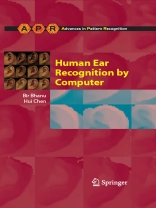Biometrics deal with recognition of individuals based on their physiological or behavioural characteristics. Researchers have done extensive studies on biometrics such as fingerprint, face, palm print, iris and gait. Ear, a viable new class of biometrics, has certain advantages over face and fingerprint, which are the two most common biometrics in both academic research and industrial applications.
This book explores all aspects of 3D ear recognition: representation, detection, recognition, indexing and performance prediction. It uses large datasets to quantify and compare the performance of various techniques.
Features and topics include: Ear detection and recognition in 2D image – 3D object recognition and 3D biometrics – 3D ear recognition – Performance comparison and prediction.
The techniques discussed will be of great interest to researchers, developers and decision makers who are involved in robust human recognition by computer for a large number of practical applications.
Table of Content
Introduction.- Ear Detection and Recognition in 2D Images.- 3D Object Recognition and 3D Biometrics.- 3D Ear Detection.- Recognizing 3D Ears Using Helix/Anti-helix.- Recognizing 3D Ears using Local Surface Patches.- Rapid 3D Ear Indexing and Recognition.- Performance Comparison and Prediction.- Conclusion and Future Work.












